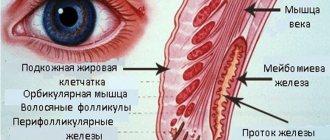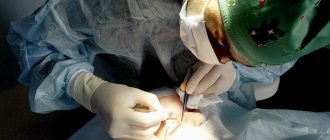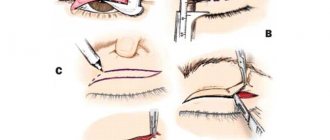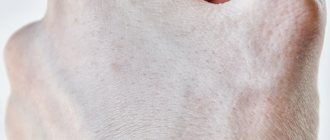Home » Blepharoplasty » Operation
Age-related changes on a woman’s face are not difficult to miss, especially in the eye area. The famous crow's feet, bags under the lower eyelids, drooping corners of the eyes, loss of radiant gaze. How to hide the negative consequences of life experiences from others? Circular blepharoplasty helps restore expressiveness and youth to a dull look.
What is circumferential blepharoplasty?
Modern blepharoplasty or circular face lift is a method of plastic surgery aimed at correcting the upper and lower eyelids to smooth out weak skin. At the time of surgery, bags and dark circles under the eyes are removed and wrinkles are straightened.
The main advantage of this method is its long-lasting effect, which lasts for a couple of years. With one operation, you will be transformed for the better and forget about the sad changes for 10-15 years.
The cost of blepharoplasty facelift depends on several factors:
- doctor's qualifications;
- complexity and volume of the operation;
- reputation of the clinic.
In different cities, the cost may differ and range from 45 to 90 thousand rubles.
When should circumferential blepharoplasty not be performed?
The operation itself is not considered by professionals to be the most difficult method, but it has its own contraindications, including:
- high intraocular pressure;
- low blood clotting or taking medications that thin or increase blood clotting;
- high blood pressure. Especially in adulthood, when blood pressure is unstable;
- various diseases of the heart and blood vessels;
- oncology;
- pregnancy and lactation;
- age less than 18 years.
If health allows, blepharoplasty can be done at 50-60 years of age. Some contraindications are relevant only for female patients.
If there is excessive formation of subcutaneous fat deposits on the eyelids, transconjunctival blepharoplasty is additionally performed.
Effect of microcurrent therapy after blepharoplasty
Microcurrent therapy has proven itself to be excellent during the rehabilitation period after surgery; it promotes:
- rapid healing of wounds;
- normalization of metabolic processes;
- relieves fatigue;
- has a regenerating and drainage effect;
- restores and relaxes muscle tissue;
- helps avoid the appearance of keloid scars;
- relieves inflammation;
- removes fluid from the body, reducing swelling.
However, this therapy is not suitable for everyone. There are a number of contraindications:
- oncology;
- epilepsy;
- thrombophlebitis;
- inflammatory process of any nature;
- mental disorders;
- drug addiction and alcoholism;
- pregnancy and breastfeeding;
- diseases of the cardiovascular system;
- presence of pacemakers
Preparation stage
Before surgery, you must undergo a complete examination by an ophthalmologist. The specialist will examine the eyes, identify possible risk factors and write a referral for blepharoplasty or circular lift. A couple of days before surgery, you need to do a list of clinical studies:
- blood chemistry;
- Analysis of urine;
- analysis of blood electrolytes;
- analysis for the detection of AIDS, syphilis, hepatitis, HIV;
- ECG;
- fluorography.
We recommend: Do you feel pain after blepharoplasty?
Preparation for circumferential blepharoplasty surgery
Before the operation, the surgeon sets several requirements for the patient in order to eliminate negative aspects that could complicate the operation. The list of requirements includes:
- refusal to eat 8 hours before surgery;
- stopping smoking a few hours before surgery;
- the day of the operation, if the patient is a woman, then the date should be set a week before the start of menstruation or after its completion;
- refusal to take medications that affect blood clotting within a couple of days.
After surgery, you will need to be accompanied by relatives, so you need to take care of this in advance. It is better to ask someone from your family to wait for you at the clinic.
How is the operation performed?
The surgical time is 1-3 hours, depending on the complexity of the measures performed. The surgeon takes into account the degree of age-related changes, the level of ptosis, and the general condition of the patient. And only after analyzing the entire picture of changes, he draws up an operation plan. For comfort and accuracy of making the necessary incisions, the surgeon makes marks on the patient’s face in advance.
At the first stage, the skin is treated with disinfected agents to prevent infection of the wounds and to ensure the normal course of the recovery period. During lower eyelid surgery, a classic incision is made along its line. All procedures for circumferential blepharoplasty are performed under local anesthesia.
At the time of surgery, after circumferential blepharoplasty, fat deposits can be excised if the patient has them. Then plastic surgery of the upper eyelid is done. Incisions are made using a scalpel or laser. The latter option involves more beautiful, even and delicate cuts. They tighten faster and cause less damage to the tissue.
Features of performing the operation under local anesthesia
Regardless of the type of anesthesia chosen, the preparation stage will be approximately the same: the patient needs to undergo a standard set of tests, temporarily give up alcohol, smoking and a number of medications.
Moreover, the doctor necessarily studies his allergological and anesthesiological history: has there been any surgery in the past, what kind of anesthesia was used, did it lead to negative consequences, is there any personal intolerance to drugs - all this is necessary to exclude the possibility of anaphylactic shock and other serious complications .
Before the surgical intervention begins, the doctor makes marks on the skin with a special marker. Then the entire face is treated with an antiseptic, injections are given to block the pain syndrome, and when they take effect, the work begins.
During the injections themselves, you will have to be patient: they are uncomfortable, since the anesthetic drug is injected deep into the skin, into the very sensitive and delicate eye area.
Already during the operation there will be no pain, but patients can feel the pressure of surgical instruments and the movement of threads at the time of suturing - much the same as people feel the actions of a dentist inside the teeth and gums. Moreover, you will have to look at the blinding light of surgical lamps, and when using a laser scalpel, you can still smell the smell of burnt meat.
For many, such sensations cause nervous tension and other negative reactions, so local anesthesia is almost always supplemented with oral sciatic medications - they make the person calm and sleepy.
We recommend: Is it possible to have blepharoplasty?
For patients with a very low pain threshold or increased anxiety, intravenous sedation may be indicated instead of oral sedation, at which time consciousness is completely switched off. Subjectively, this option is almost no different from general anesthesia: the only difference is in the dosage of drugs and the possibility of spontaneous breathing.
The activity and duration of local anesthesia depends on the volume of the drug administered, its concentration, as well as the personal characteristics of the human body. It happens that right at the time of surgery, the effect of the anesthetic weakens and sensitivity returns. You need to tell the surgeon about this so that he can administer an additional drug.
Upon completion of the plastic surgery, the patient is taken to the ward to monitor his condition for 2-3 hours. If no problems appear at this stage, painkillers are prescribed in the form of tablets or intramuscular injections (analgin, paracetamol), after which you can go home.
But often blepharoplasty under local anesthesia is even necessary, since in case of asymmetry of skin folds, only by communicating with the patient and controlling how the line of the future scar fits into the natural fold of the skin and what distance remains from the eyebrows, you can get an even result.
Many women are interested in whether it is painful to have blepharoplasty under local anesthesia. This question will be answered by women who have already undergone surgery and all the difficulties of the rehabilitation period.
Features of the rehabilitation period after circular blepharoplasty
The recovery period after circular blepharoplasty begins with the use of cold compresses with ice or special gels. After such manipulations, the patient can open his eyes. The healing process is carried out under the supervision of a doctor. A schedule of visits to the surgeon is given to the patient upon discharge.
For a quick and proper recovery after circular blepharoplasty, you need to follow the rules:
- do not perform physical activity for 3 days after surgery;
- sleep on your back on a high pillow;
- if you wore contact lenses before the operation, you will have to walk around without them for the first time;
- You cannot use decorative cosmetics for 10 days;
- you need to limit yourself to watching TV, reading books and working on the computer;
- do not bend forward frequently;
- wear sunglasses when going outside;
- as a preventive measure, apply drops prescribed by your doctor to your eyes for 3 days;
- for quick recovery you need to do lymphatic drainage massage, soft peeling, and skin tightening.
We recommend: What is upper eyelid blepharoplasty?
Special physiotherapeutic procedures are used as effective aids for rapid rehabilitation. The most effective procedure is microcurrent, which helps eliminate hematomas, speed up healing of wounds, and improve blood flow in the surgical area.
Complications of blepharoplasty
Many people are concerned about the question: is blepharoplasty dangerous? Unfortunately, complications often occur:
- superficial bruising and hematoma. To minimize bruising, do not take medications that interfere with blood clotting. It is important to control blood pressure, if any, to exclude the possibility of postoperative injury and physical activity. Excessive bruising can prolong recovery and increase the risk of infection, scarring, and skin pigmentation. During rehabilitation, the patient must help himself by applying cold compresses for 3 days. You also need to keep your head elevated while sleeping. Rare intraorbital bleeding provokes an increase in intraocular pressure and damages the optic nerve. Blindness caused by retrobulbar hematoma occurs in 0.04% of cases after surgery. For small hematomas, steroids are used;
- divergence of seams. Reducing the risk of divergence of the ends of the incision depends on the choice of suture material and its proper application. Non-absorbable prolene sutures are often used for upper blepharoplasty, as silk and absorbable sutures increase the risk of tissue reaction or wound dehiscence. The stitches are removed on day 7-8. Mild dehiscence can be treated with antibiotics, but complete dehiscence requires prompt surgical debridement to prevent contraction of the lower eyelid and scar formation;
- scars. Sometimes the incision line may appear hypertrophied, especially if patients have a hereditary tendency to scar hypertrophy and depigmentation (black and Asian patients are at risk for this). Sometimes, instead of scar hypertrophy, epithelial cysts are formed. The risk of creating granulomas at the suture site is reduced with the help of prolene sutures, which are completely eliminated after a certain time. Cutting the conjunctiva can sometimes produce pyogenic granulomas, which can be treated with short-term steroid use. Otherwise, the pyogenic granuloma is removed;
- hypercorrection of the upper eyelids. External and functional impairment may occur due to the excision of large amounts of skin and fat, excessive scarring and injury to the aponeurosis that raises the muscle. Trauma to the levator muscle, aponeurosis, and aponeurotic fat tissue leads to problems with eyelid closure and lagophthalmos. Lagophthalmos is considered a change in which the eye partially closes. This is the most common cause of dry eyes after blepharoplasty. Removal of too much skin can be corrected with a behind-the-ear skin graft, which is considered an ideal replacement for eyelid skin. The skin graft is implanted into the crease of the upper eyelid. Excessive fat removal results in visual hollowing in the upper eyelids. Filling such areas can be problematic and requires the use of fat injections or alloplastic injections. The risks are high and may cause short-term effects, scarring, uneven contours and ptosis of the eyelid. Loss of vision and vascular emboli may occur with inadvertent intravenous or intra-arterial administration of these materials, particularly near the supraorbital vessels;
- hypercorrection of the lower eyelids. Postoperative changes in the position of the eyelids (ptosis) may appear after lower blepharoplasty. The main causes of lower eyelid malposition are considered to be removal of too much skin or scarring. If a scar forms early, local steroid injections can sometimes eliminate the need for major intervention;
- asymmetry. Asymmetry of the eyelids, which appeared due to inaccurate measurement or an error made during the operation, is corrected surgically. Careful preoperative marking will minimize this outcome. Many small irregularities disappear over time;
- ptosis. Ptosis is considered common in upper blepharoplasty patients. This is a condition in which the upper eyelid drops below its normal level and the upper eyelid muscle is unable to lift it. The mechanism of ptosis may be myogenic, neurogenic, mechanical, or aponeurotic. The main cause of postoperative eyelid ptosis is considered to be swelling, which causes mechanical limitation of the actions of the levator muscles. Bruising can also cause limited movement of the levator muscles. Ptosis can form due to the creation of adhesions or inaccurate excision of fat bags. If the levator muscle is not injured, then persistent postoperative ptosis usually persists for 3 months, then goes away. If suddenly this does not happen, then the problem is solved surgically;
- lacrimation and discomfort in the eyes. Lagophthalmos can increase tear production, leading to active lacrimation, which can be treated with eye drops and ice packs. Microscopic injuries to the cornea can lead to pain, foreign body sensation, and watery eyes. To prevent the occurrence of infectious keratitis, you must first take measures to treat the corneal epithelium. Lacrimation can cause injury to the lacrimal ducts at the time of surgery;
- diplopia. Diplopia, or double vision, is an extremely rare complication after blepharoplasty. The most popular reason is the direct injection of a local anesthetic into the fat during lower blepharoplasty or into the skin during upper blepharoplasty. It is characterized by a faster and wider spread of local anesthetic that affects other structures.
We recommend: How to remove seals on the lower eyelid after blepharoplasty?
How is the healing process carried out after a circular facelift?
If you decide to have circular blepharoplasty, then get ready for the complete healing process to last more than a month. For a better understanding, let’s look at the changes after circular blepharoplasty by day:
- 1st day - the effect of anesthesia ends, increasing pain and swelling appear. To eliminate unpleasant symptoms, you need to take painkillers and apply cold compresses;
- Day 2-3 – double vision and fear of light appear, which are not complications, but are considered a normal reaction of the body to the intervention performed. To reduce discomfort, you need to drip your eyes with antiseptic drops;
- 4-5th day - swelling, double vision and fear of light go away. The surgeon removes the stitches. Physical activity and bending forward are prohibited;
- 6th day – traces of bruises are still noticeable, but the swelling goes away;
- 7th day - hematomas and swelling completely disappear. The patient is allowed to walk, but wear sunglasses;
- 8-10th day – half of the swelling remains. You can use decorative cosmetics little by little;
- Days 11-14 – looking in the mirror, you can see the result of the operation. You can wear contact lenses and do light physical activity;
- 15-20th day – slight asymmetry of the eyelids may appear;
- 1-2 months after circular blepharoplasty – scars are almost invisible.
The rehabilitation period can be considered over.
Is it true that after surgery the eyelids look lifeless and the lower eyelid may sag?
It all depends on the skill and experience of the surgeon. Qualified specialists who have performed many operations recently and experience are the ideal guarantee that blepharoplasty will be done with complete preservation of the normal condition of the eyelids. Only excess skin is removed. The doctor won’t cut off too much skin; you shouldn’t be afraid of that.
We recommend: How do scars heal after blepharoplasty?
Immediately after the operation, your appearance may be a little scary - as bruising and swelling will appear on your face. Because of them, at first it will seem that the eyelid is tightened and in an unnatural position. But these sensations quickly pass as soon as the rehabilitation period is completed and the swelling goes away.
Removing Consequences
In many situations, post-operative scars are successfully eliminated by 10-12 weeks after an eyelid lift. Sometimes, due to the hereditary predisposition of the patient’s body, a medical error or a violation of the rehabilitation period, a procedure for grinding the sutures may be required.
The procedure is carried out using erbium lasers. To completely remove scars, you need to perform 5-7 procedures. The cost of grinding sutures after circular blepharoplasty varies from 37 to 55 thousand rubles per procedure.
Under the influence of the laser, the deep layers of the skin are accelerated. The formation of collagen and elastin is enhanced, deformed tissues are pushed out, smoothed out and replaced with new ones.
Mesotherapy is aimed at overall rejuvenation of skin cells. The procedure involves injections of multivitamins, amino acids, hyaluronic acid, and homeopathic compounds that promote cell renewal.
We recommend: How is blepharoplasty for bags under the eyes performed?
Fractional thermolysis or photothermolysis helps eliminate seams. When it is performed, the laser beam is broken into many small beams, which cover a large area and work precisely on each affected area.
Mesotherapy
Types of circular blepharoplasty
Today, doctors use two types of blepharoplasty: laser and traditional. With laser circumferential blepharoplasty, no incisions are made. Correction is carried out by puncturing the conjunctiva with a laser beam while simultaneously removing fat deposits.
A few hours after the procedure, the patient can safely go home. The recovery period is also significantly reduced, because after laser exposure there are no bruises, swelling or scars left on the face.
The traditional method involves making abdominal incisions in the eyelids, through which fat deposits are excised. Stretched areas of skin are cut off, the remaining tissues are tightened and fixed in special anchor areas, which are located in the eye area.
How is blepharoplasty done?
You cannot do without general anesthesia for blepharoplasty. This is only possible when planning a technically simple, small-scale operation - for example, isolated correction of the upper eyelids - and the patient himself is mentally ready to endure it while remaining fully conscious. In this case, local anesthesia has obvious advantages:
- minimal likelihood of complications associated with the effects of heavier drugs for general anesthesia;
- the ability to open and close the eyes on command, which greatly simplifies the surgical procedure for the surgeon and reduces the risk of under- and over-correction;
- After the operation, you can stay in the hospital for a couple of hours, then you can safely go home. All further actions are carried out on an outpatient basis.
Anesthesia for blepharoplasty
But there are also disadvantages:
- in the absence of general anesthesia and nervous tension, the patient’s blood pressure will be high - this does not threaten health, but may interfere with the surgeon;
- there remains a small probability of allergies and other undesirable reactions to injected medications.
There are two ways to block pain sensitivity without putting a person to sleep:
- application - an anesthetic cream or spray is applied to the skin area, and after a few minutes it becomes numb. The main disadvantage of this option is that the effect almost does not affect the subcutaneous fat and muscles, so it is used only for minimally invasive procedures such as Botox injections or contouring;
- injection - when the anesthetic is injected using a syringe with a thin needle. In this case, it penetrates into much deeper layers of the dermis and tissues and acts much longer.
We recommend: Classic blepharoplasty technique
For surgical eyelid surgery, only the second method is used. Certain drugs may be different; they are selected by the surgeon or anesthesiologist individually for the patient. These are usually drugs based on lidocaine, ultracaine and bupivacaine. But novocaine, popular among cosmetologists, is not suitable due to its short action time.
Prognosis and possible complications
If the operation is performed professionally and the patient follows all recommendations during the recovery period, the prognosis is positive. Rarely there are complications such as:
- increased tearfulness;
- discomfort when closing the eyelids;
- hematomas on the eyeballs;
- severe pain.
Patients who were negligent in choosing a surgeon and clinic, or who believed false advertising, may experience more serious consequences:
- constant dryness of the eyeballs;
- seam divergence;
- scar formation;
- infection and prolonged bleeding of incisions;
- inversion of the lower eyelids.
Modern plastic surgery capabilities make it possible to perform the most complex operations. Circular blepharoplasty is a well-established method for correcting external changes in the eye area. If you find that bags, hernias and drooping eyelids are causing you severe discomfort, do not be afraid to resort to this type of eyelid lift. It is important to thoroughly study the issue and prepare well for surgery.
YouTube responded with an error: The request cannot be completed because you have exceeded your quota.
Rate this article:
- Related Posts
- How is blepharoplasty performed for wrinkles under the eyes?
- How many years do the results after blepharoplasty last?
- What is the age limit for blepharoplasty?
- When is blepharoplasty needed?
- Features of preparation for blepharoplasty surgery
- Where is blepharoplasty performed?











